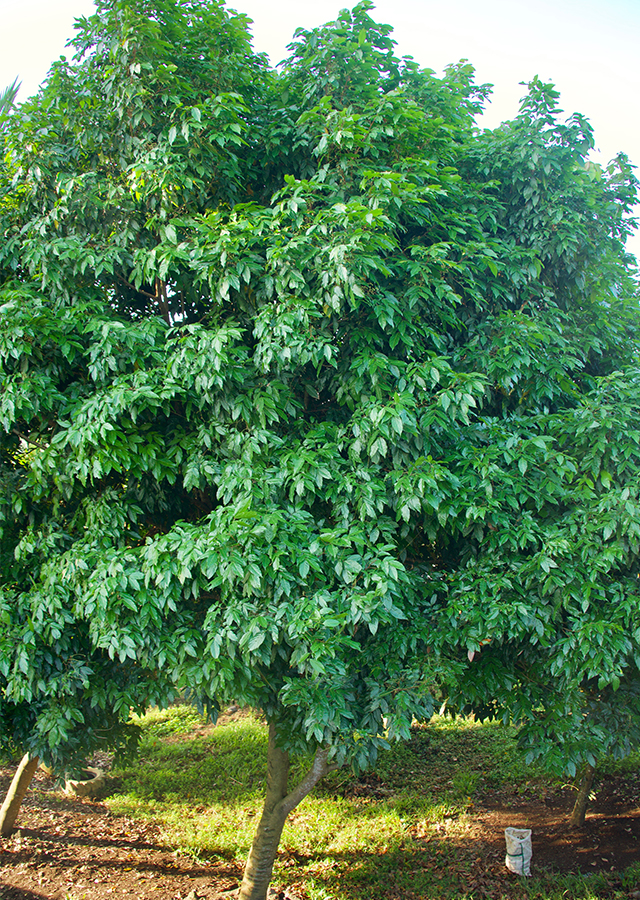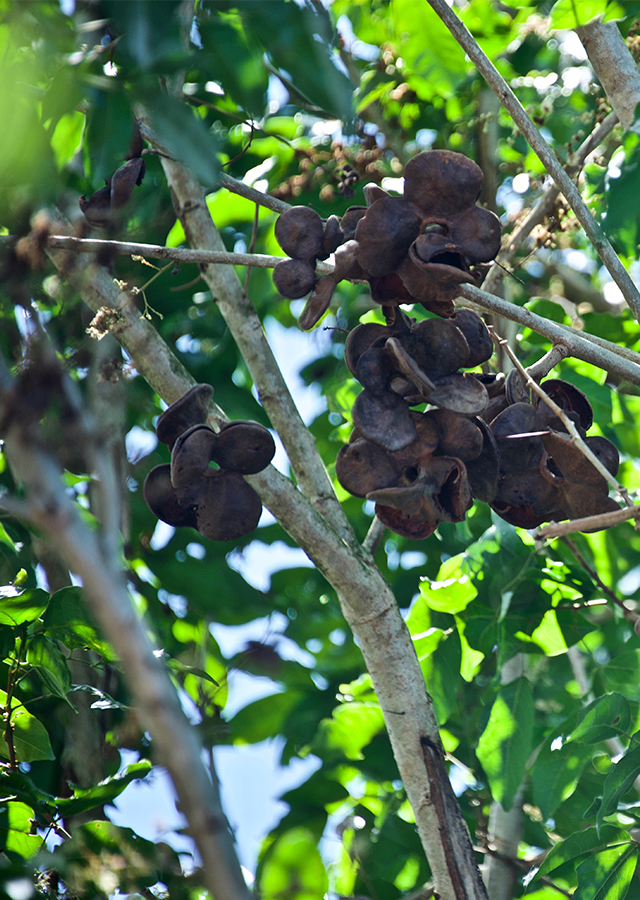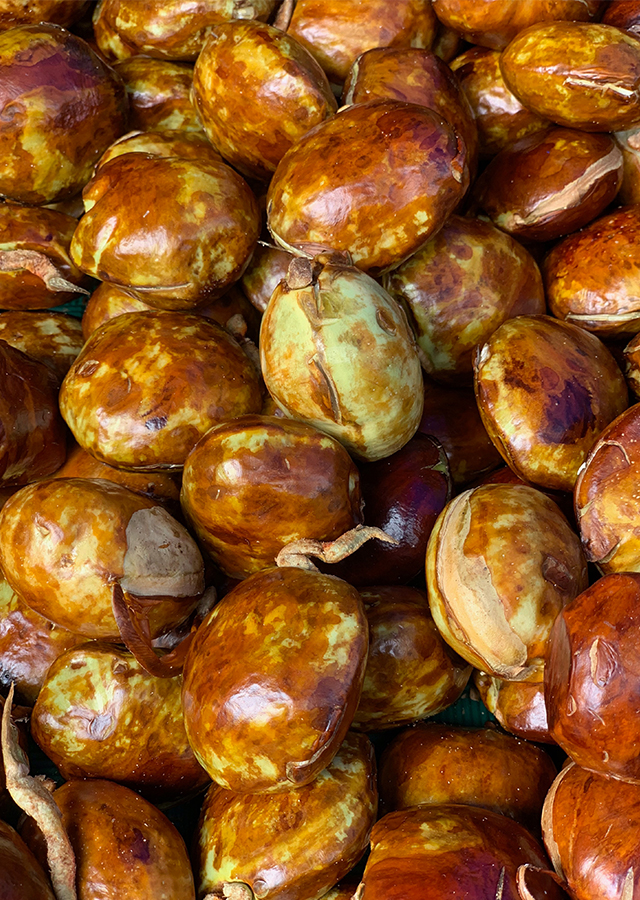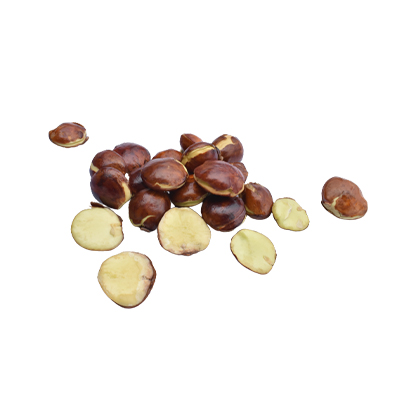Dog fruit
Archidendron jiringa (Jack) I.C.Nielsen
Fabaceae
Location in our garden
Orchard



Synonym
Albizia jiringa (Jack) Kurz
Feuilleea jiringa (Jack) Kuntze
Inga attenuata Graham
Habitus
Trees. Medium sized tree about 18–25 m tall with a spreading crown and multi branched
Part Used
Leaves
Seeds
Bark
Rind
Growing Requirements
Full Sunshine
Need Shade
Habitat
Forest
Overview
A. jiringa origin is from South-East Asian and occurs wild and cultivated in Malaysia, Indonesia (Java, Sumatra, Kalimantan), Brunei, Thailand, Burma and Bangladesh. In Southeast Asia, the seed is a common vegetable. Flowering and fruiting are year-round, but peak periods occur. The seeds contain a volatile oil consisting of an allyl sulphur compound and an alkaloid, which act as diuretic. They also contain toxin known as jengkolic acid (C7H1404N2S2) that may lead to the 'kejengkolan' disease, caused by crystallization of jenkolic acid in the kidneys and bladder, with the following symptoms: renal hyperemia, oliguria to no urination at all, and pain when urinating.
Vernacular Names
Cha niang (Thai), Jering (Malay), Danyin (Burmese), Dhinyindi (Nepalese), Jengkol (Indonesia).
Agroecology
It is recorded from sandy soil, lateritic soil, reddish sandy clay, flat land and low undulating hills, from sea-level up to 1000(-1600) m altitude. It grows well in full sun and light shade in well-drained soil.
Morphology
- Stem up to 20 m tall with grey smooth bark, white wood and terete, glabrous branchlets.
- Leaves - 2-pinnate, up to 25 cm long; petiole 2-6 cm long; leaflets 2-3 pairs per pinna, ovate-elliptical to oblong, 8-15 cm x 4-5 cm, opposite, chartaceous,mglabrous, dark violet-red when young.
- Flowers – Inflorescence axillary, paniculate, up to 20 cm long; flowers sessile, 4-7 together in a pseudo-umbel on a short peduncle, 5-merous, bisexual; calyx cupshaped; corolla tubular, 4-5 mm long, 5-lobed, white; stamens numerous, at base united into a tube, free filament parts ca. 5 mm long.
- Fruits – a legume, compressed, falcate or twisted in a wide spiral, more or less deeply lobed along the ventral suture between the seeds, 2Q-25 cm x 3-4 cm, woody, greyish, glabrous, dehiscent along the ventral suture.
- Seeds – compressed orbicular, ca. 35 mm x 10 mm, testa yellow-green when young, turning dark brown. Germination is hypogeal and the first five leaves are scale-shaped.
Cultivation
A. jiringa is propagated by seeds. It starts bearing 5-6 years or more after sowing. Planting distances are l0-15 m. A mature tree produces 1000-4000 seeds/year. Seed weight is approximately 15 g per seed. The main harvest period in Java is in July-August, the after-crop in December-February. Growing space is 10 - 15 m apart.
Chemical Constituents
The seed contains amino acid (cysteine), terpenoid, fenolic acid (methyl gallate), flavonoid, polifenol, lectin, tannin, sulphur compound, jengkolic acid, alkaloid, and saponins.
Traditional Medicinal Uses
- It is rich in iron, which is very effective in preventing and overcoming the lack of red blood cell development in the body (prevent anemia).
- Calcium and phosphorus substances are important for preventing bone loss and for strengthening bones and teeth.
- The seed is ideal for relieving diabetes symptoms, decreasing urinary stones or urolithiasis. It has hypoglycemic and anti-oxidant activities. Jering leaves have been used as a poultice for skin irritation, chest pain and as wound powder. The old leaves are burned and the ashes is applied to itching. For cuts and circumcision wounds, powder from scorched young leaves was added. The bark was also used for chest pain and to produce a gargle for tooth pain.
- Seeds in small quantities are applied as diuretic, but they are poisonous in large quantities.Seed is used as vegetable and can be processed as chips (emping or keripik jengkol).
- The pods were used as a source of purple dye for silk in the past; they are still used as a shampoo.
- In Kalimantan, the bark is used for dyeing matting black; to obtain this colour the mat is boiled with extract from the bark and then immersed in mud.
- The timber is soft, easy to saw and to work with; therefore it is only suitable for cabinet work, interior joinery or as firewood.
Part Used
Reference Sources
- Health Benefit Times. (No date). Health benefits of Ngapi Nuts. https://www.healthbenefitstimes.com/ngapi-nuts/. 02-11-2020.
- Lim, T.K. (2012). Edible Medicinal And Non-Medicinal Plants: Volume 2, Fruits. 544.
- PFAF. (No date). Archidendron jiringa (Jack) I.C.Nielsen. https://pfaf.org/user/Plant.aspx?LatinName=Archidendron+jiringa. 02-12-2020.
- Fern, Ken. (2014). Useful Tropical Plants. Archidendron jiringa http://tropical.theferns.info/viewtropical.php?id=Archidendron+jiringa 09-07-2020.
- Wiriadinata H. 1994. Archidendron jiringa (Jack) Nielsen. In: Siemonsma, J.S. and Piluek, K. (Editors): Plant Resources of South-East Asia No 8. Vegetables. Prosea Foundation, Bogor, Indonesia. P 89-90.



